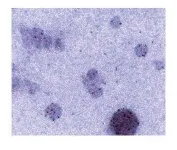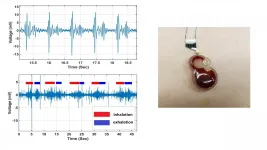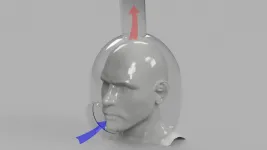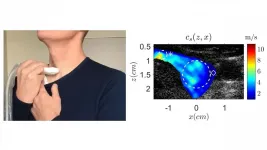(Press-News.org) The daily toll of COVID-19, as measured by new cases and the growing number of deaths, overlooks a shadowy set of casualties: the rising risk of mental health problems among health care professionals working on the frontlines of the pandemic.
A new study, led by University of Utah Health scientists, suggests more than half of doctors, nurses, and emergency responders involved in COVID-19 care could be at risk for one or more mental health problems, including acute traumatic stress, depression, anxiety, problematic alcohol use, and insomnia. The researchers found that the risk of these mental health conditions was comparable to rates observed during natural disasters, such as 9/11 and Hurricane Katrina.
"What health care workers are experiencing is akin to domestic combat," says Andrew J. Smith, Ph.D., director of the U of U Health Occupational Trauma Program at the Huntsman Mental Health Institute and the study's corresponding author. "Although the majority of health care professionals and emergency responders aren't necessarily going to develop PTSD, they are working under severe duress, day after day, with a lot of unknowns. Some will be susceptible to a host of stress-related mental health consequences. By studying both resilient and pathological trajectories, we can build a scaffold for constructing evidence-based interventions for both individuals and public health systems."
The study appears in the Journal of Psychiatric Research. In addition to U of U Health scientists, contributors include researchers from the University of Arkansas for Medical Sciences; University of Colorado, Colorado Springs; Central Arkansas VA Health Care System; Salt Lake City VA Healthcare System; and the National Institute for Human Resilience.
The researchers surveyed 571 health care workers, including 473 emergency responders (firefighters, police, EMTs) and 98 hospital staff (doctors, nurses), in the Mountain West between April 1 and May 7, 2020. Overall, 56% of the respondents screened positive for at least one mental health disorder. The prevalence for each specific disorder ranged from 15% to 30% of the respondents, with problematic alcohol use, insomnia, and depression topping the list.
"Frontline providers are exhausted, not only from the impact of the pandemic itself, but also in terms of coping day to day," says Charles C. Benight, Ph.D., co-author of the study and a professor of psychology at the University of Colorado, Colorado Springs. "They're trying to make sure that their families are safe [and] they're frustrated over not having the pandemic under control. Those things create the sort of burnout, trauma, and stress that lead to the mental health challenges we're seeing among these caregivers."
In particular, the scientists found that health care workers who were exposed to the virus or who were at greater risk of infection because they were immunocompromised had a significantly increased risk of acute traumatic stress, anxiety, and depression. The researchers suggest that identifying these individuals and offering them alternative roles could reduce anxiety, fear, and the sense of helplessness associated with becoming infected.
Alcohol abuse was another area of concern. About 36% of health care workers reported risky alcohol usage. In comparison, estimates suggest that less than 21% of physicians and 23% of emergency responders abuse alcohol in typical circumstances. Caregivers who provided direct patient care or who were in supervisory positions were at greatest risk, according to the researchers. They say offering these workers preventative education and alcohol abuse treatment is vital.
Surprisingly, health care workers in this study felt less anxious as they treated more COVID-19 cases.
"As these health care professionals heard about cases elsewhere before COVID-19 was detected in their communities, their anxiety levels likely rose in anticipation of having to confront the disease," Smith says. "But when the disease started trickling in where they were, perhaps it grounded them back to their mission and purpose. They saw the need and they were in there fighting and working hard to make a difference with their knowledge and skills, even at risk to themselves."
Among the study's limitations are its small sample size. It was also conducted early in the pandemic in a region that wasn't as affected by the disease as other areas with higher infection and death rates.
Moving forward, the researchers are in the final stages of a similar but larger study conducted in late 2020 that they hope will build on these findings.
"This pandemic, as horrific as it is, offers us the opportunity to better understand the extraordinary mental stress and strains that health care providers are dealing with right now," Smith says. "With that understanding, perhaps we can develop ways to mitigate these problems and help health care workers and emergency responders better cope with these sorts of challenges in the future."
INFORMATION:
In addition to Dr. Smith, Hannah M. Wright, Tiffany M. Love, and Scott A. Langenecker of University of Utah Health contributed to this study. The study, "Pandemic-related mental health risk among front line personnel," was published in the Journal of Psychiatric Research.
LOS ANGELES (Jan. 11, 2021) -- Cell-derived exosomes are effective in treating disease when mixed with the dominant protein in breast milk and given orally, a new Smidt Heart Institute study of laboratory mice shows. The findings, published in the peer-reviewed Journal of Extracellular Vesicles, could help develop new oral medications for treating patients with muscular dystrophy and heart failure.
The study builds on more than a decade of research led by Eduardo Marbán, MD, PhD, executive director of the Smidt Heart Institute and Cedars-Sinai professor of Cardiology. The research has focused on human cardiosphere-derived ...
Most consumers of drinking water in the United States know that chemicals are used in the treatment processes to ensure the water is safe to drink. But they might not know that the use of some of these chemicals, such as chlorine, can also lead to the formation of unregulated toxic byproducts.
Johns Hopkins Environmental Health and Engineering Prof. Carsten Prasse proposes a new approach to assessing drinking water quality that could result in cleaner, safer taps.
"We are exposing people in the United States to these chemical compounds without knowing what they ...
During a typical year, over a million people visit Yellowstone National Park, where the Old Faithful geyser regularly blasts a jet of boiling water high in the air. Now, an international team of astronomers has discovered a cosmic equivalent, a distant galaxy that erupts roughly every 114 days.
Using data from facilities including NASA's Neil Gehrels Swift Observatory and Transiting Exoplanet Survey Satellite (TESS), the scientists have studied 20 repeated outbursts of an event called ASASSN-14ko. These various telescopes and instruments are sensitive to different wavelengths of light. By using them collaboratively, scientists obtained more detailed pictures of the outbursts.
"These are the most predictable and frequent recurring multiwavelength ...
WASHINGTON, January 12, 2021 -- A highly sensitive wearable sensor for cardiorespiratory monitoring could potentially be worn continuously by cardiac patients or others who require constant monitoring.
The small and inexpensive sensor, announced in Applied Physics Letters, by AIP Publishing, is based on an electrochemical system involving two ionic forms of iodine, I- and I3-. A solution containing these electrolyte substances is placed into a small circular cavity that is capped with a thin flexible diaphragm, allowing detection of subtle movements when placed on a patient's chest.
Small motions that arise from the heartbeat and breathing cause the flexible diaphragm ...
Stiffness in our tissues causes tension in our cells. Research from the Buck Institute, the University Health Network (University of Toronto), Stanford University, and the University of Alberta shows that stiffness impacts the innate immune system by upping its metabolism. The findings suggest the cellular tension likely sets off an inflammatory loop that contributes to the development of chronic diseases of aging. Publishing in Cell Reports, Buck Associate Professor Dan Winer, MD, and colleagues present an emerging way of looking at how the immune system functions, possibilities for new immunotherapeutics, and a call for scientists to reconsider the way they do research.
While stiffness ...
WASHINGTON, January 12, 2021 -- The risk of infection of COVID-19 is high for medical specialists who come in contact with symptomatic or asymptomatic patients. Dentists and otolaryngologists are at particular risk, since they need direct access to the mouth, nose, and throat of patients.
The current solutions, which include wearing N95 masks and face shields, clinic room evacuation, negative pressure rooms, and special air filtration systems, are expensive, not highly effective, and not very accessible.
In Physics of Fluids, by AIP Publishing, researchers at Cornell University discuss their design of an open-faced helmet for patient use ...
WASHINGTON, January 12, 2021 -- Sodium-ion batteries are a potential replacement for lithium batteries, but the anodes -- positively charged electrodes -- that work well for lithium-ion batteries don't provide the same level of performance for sodium-ion batteries.
Amorphous carbon, which lacks a crystalline structure, is known to be a useful anode, because it has defects and voids that can be used to store sodium ions. Nitrogen/phosphorus-doped carbon also offers appealing electrical properties.
In Applied Physics Reviews, from AIP Publishing, researchers in China from Zhejiang University, Ningbo University, and Dongguan University of Technology ...
What The Study Did: Variations and changes in national and state rates of neonatal abstinence syndrome and maternal opioid-related diagnoses were examined in this observational study.
Authors: Ashley H. Hirai, Ph.D., of the Health Resources and Services Administration in Rockville, Maryland, is the corresponding author.
To access the embargoed study: Visit our For The Media website at this link https://media.jamanetwork.com/
(doi:10.1001/jama.2020.24991)
Editor's Note: The article includes conflicts of interest and funding/support disclosures. Please see the article for additional information, including other authors, author contributions and affiliations, conflict of interest and financial disclosures, and funding and support.
INFORMATION:
Media advisory: ...
WASHINGTON, January 12, 2021 -- Singing may be the next-generation, noninvasive approach to determining the health of a patient's thyroid.
Typically, a fine needle is used to detect the presence of a tumor in the thyroid, which most commonly affects children and younger women. However, this method can only detect about 5% of thyroid cancers.
Researchers from Université de Tours, Centre Hospitalier Universitaire de Dijon-Bourgogne, and Université Bourgogne Franche-Comté suggest a simpler approach: singing. They demonstrate the technique in the journal Applied Physics Letters, from AIP Publishing.
"Developing noninvasive methods would reduce the stress of patients during their medical exams," said Steve Beuve, one of the authors. "Having to sing during a medical ...
What The Study Did: National register data from Denmark were used to examine if people with autism spectrum disorder (ASD) have higher rates of suicide attempts and suicide compared to those without ASD and to identify potential risk factors.
Author: Kairi Kõlves, Ph.D., of Griffith University in Brisbane, Australia, is the corresponding author.
To access the embargoed study: Visit our For The Media website at this link https://media.jamanetwork.com/
(doi:10.1001/jamanetworkopen.2020.33565)
Editor's Note: The article includes funding/support disclosures. Please see the article for additional information, including other authors, author contributions and affiliations, conflict ...




